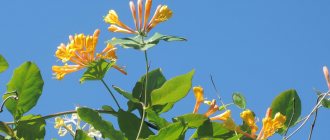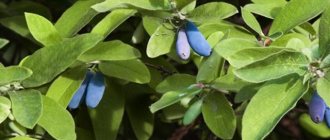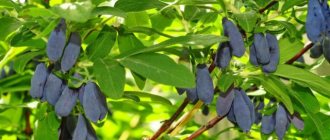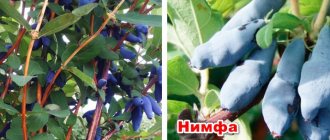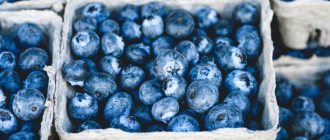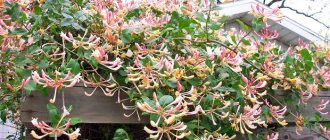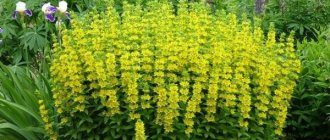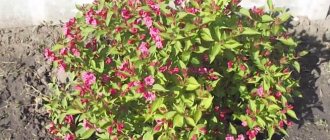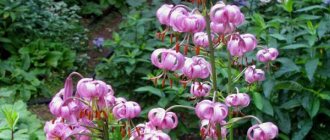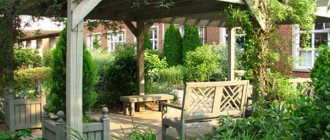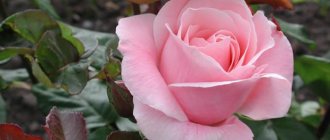Honeysuckle Honeysuckle is ideal for landscaping a personal plot. Such a “hedge” participates in the creation of landscape designs, improves the area, provides shade, and helps create a cozy place to relax. More than 10 species of honeysuckle are known, including climbing honeysuckle.
Honeysuckle Honeysuckle
Honeysuckle Honeysuckle blooms for about 3 weeks
Honeysuckle flowers Honeysuckle have a pleasant aroma
Description of Honeysuckle Honeysuckle
Honeysuckle Honeysuckle has a pleasant aroma and unique flowers, creating comfort and shade in the garden or in the gazebo. In the wild, the plant is found in southern Europe, in the Caucasus mountains, and lives up to 50 years.
The original name of honeysuckle Honeysuckle is Lonicera caprifolium, which translated means “folium” - leaf, “carpa” - goat. These curly bushes up to 6 m long have different shades of colors and always attract the attention of passers-by.
Appearance
The shrub has bright green ellipsoidal leaves, vertically growing branches 4-5 m long (depending on the age of the honeysuckle). Gray-green shoots turn red in the sun and tightly wrap around any support. The leaves gradually grow together into a disc, in the middle of which first a flower is formed, then a bunch of ripe berries.
Honeysuckle flowers have a subtle pleasant aroma and decorative appearance. They become a source of inspiration and a symbol of beauty, but they are not edible and do not contain medicinal properties. This is a characteristic difference between Honeysuckle and other varieties of honeysuckle. The plant smells intensely in summer, and the aroma intensifies in the evening.
Honeysuckle has red, blue, purple, white and yellow flowers. When ripe in late July or early August, they turn deep orange or bright red. Each flower individually lives no more than 3 days, after which it fades. The flowering period of the entire shrub lasts no longer than 3 weeks.
Growth
If there is support, honeysuckle grows up to 6 m in length. Thanks to this property, the shrub becomes a vertical gardening for summer cottages and garden plots. For proper growth, form the bush during the planting period, find reliable support for it. Otherwise, honeysuckle loses its decorative appearance.
In the wild, Honeysuckle is found on sunny edges and in forests, and grows up to 1 meter in length in a year. Due to its beauty and vertical tortuosity, it has been planted in Russian gardens since the 19th century.
Varieties of honeysuckle
Honeysuckle is considered the most beautiful representative of honeysuckle among 10 varieties. Gardeners are attracted by the variety of colors and shades, the preservation of the decorative appearance even after the bush has flowered. The most popular honeysuckle varieties Honeysuckle with a brief description:
- Few-flowered . The bush is pale red in color with a small number of flowers.
- Alba . Early flowering bush, blue or white flowers.
Other decorative varieties of honeysuckle are also used to create landscape design:
- Inga . Flowers are white, pink, red and yellow with an intense scent, collected in capitate inflorescences.
- Telman . The flowers are hot yellow in color with a moderate aroma and look like lights on the bushes.
- Belgica Select . The flowers are purple or pink, the fruits are red. The plant blooms 2 times a year - in May, then in August-September.
- Harlequin . The flowers are pale pink in color with a moderate aroma, decorating many gazebos in the garden.
- Graham Thomas . The flowers are long, white-yellow in color with a pleasant aroma. They bloom from the second half of July to September.
Types and popular varieties
The genus Honeysuckle includes up to 200 species of shrubs and vines, including crops with edible fruits. In gardening, preference is given to decorative climbing species. Their densely leafy stems rise high, the flowers are unusually beautiful and often fragrant. The fruits are painted in bright colors. In climbing vines they are often poisonous.
The most ancient and famous cultivated species of honeysuckle is honeysuckle. Honeysuckle (or fragrant). This vine blooms earlier than others, in June. Cream or pink-yellow lush flowers bloom in the late afternoon and fill the entire garden with their aroma, attracting butterflies. From mid-summer the flowers darken, even to brown shades. In autumn, honeysuckle is strewn with brightly colored fruits, turning red in a ring of large fused leaves. This species is winter-hardy.
Honeysuckle Honeysuckle
Much more thermophilic. Curly (German, Lithuanian). Its white, pink or purple flowers are excellent honey plants, and its purple fruits are poisonous. The most striking variety of this species is “Serotina”. The vines of this variety are decorated with crimson flowers.
Honeysuckle ClimbingNorth American species Brown in the middle zone requires shelter for the winter. It has very decorative foliage, dove-blue below and bright green above. Large tubular flowers are carrot-colored. The variety "Dropmore Scarlet" is interesting because of its orange-colored flowers.
Brown's honeysuckle
The hardiest species is the w. Tatar. In May, the entire bush is covered with small white or pink flowers. Varieties "Amold Red" and "Morgen Orange" - with red, "Elegant" - with striped bright red flowers.
Honeysuckle Tatarian
It is famous for its abundant flowering. Korolkova. Its soft pink flowers cover the bush so tightly that neither branches nor foliage are visible.
Honeysuckle Korolkova
Unlike other species, g. Geralda does not shed its leaves for the winter. In the spring, when young shoots begin to grow, last year's foliage falls off. The yellow flowers are very fragrant.
Gerald's Honeysuckle
Advantages and disadvantages
Having appreciated the significant benefits of honeysuckle Honeysuckle, many designers have included this ornamental plant in their landscape projects and ideas. Positive aspects of Honeysuckle Honeysuckle:
- ease of care;
- decorative appearance;
- variety of colors;
- quick adaptation to weather conditions;
- pleasant aroma;
- fast growth;
- hedge;
- creating shade and comfort in the fresh air;
- strong immunity.
When choosing a variety, keep in mind that Honeysuckle Honeysuckle has certain disadvantages and causes trouble when caring for:
- inedible fruits;
- fast flowering;
- pruning branches;
- formation of support;
- deterioration of external data during transplantation;
- the need to form a bush and regular watering.
Decorative honeysuckle: types and varieties
Decorative honeysuckle most often includes species with a climbing bush shape. They bloom profusely at the turn of spring-summer, so these species are successfully used in landscaping.
climbing honeysuckle
Here we can distinguish two main types that are most popular - honeysuckle and Brown's honeysuckle. The first one spreads its branches to 6 meters, but can only climb up to 2.5 meters up the support. Honeysuckle entwines everything in its path. Decorative honeysuckle is suitable for decorating a romantic corner, such as a gazebo. It makes a wonderful hedge.
Important! Honeysuckle is a heat-loving plant, and it may not survive on the north side.
In regions where there are cold winters, Brown's honeysuckle does not bear fruit. "Fuchsioides" "Dropmore Scarlet".
Bush honeysuckle
The most popular variety of shrub species is Tatarian honeysuckle.
This plant is perfectly adapted to harsh winters. The shrub reaches a height of up to 2.5 m, and begins to bloom at the age of three. Towards the end of spring, honeysuckle turns pink, which later becomes red berries. The color of the flowers varies among varieties.
Important! If the soil in your garden is not fertile enough, it is recommended to plant several bushes of Zabelli honeysuckle in a sunny place. It is unpretentious to natural conditions, grows up to one and a half meters, and beautiful crimson flowers grow on it.
Alpine honeysuckle.
Planting honeysuckle Honeysuckle
The plant feels comfortable in all regions of Russia, but is less common in the northern part. This is explained by the characteristics of the harsh climate. At low temperatures, honeysuckle needs special care and may freeze.
To plant a plant, choose the right time, do not disrupt the sequence of actions, and provide reliable care for seedlings and young shoots.
Boarding time
Plant honeysuckle outdoors only in early spring; before that, keep it in a greenhouse. The plant blooms in May, which is a favorable period for the root system and fruits.
When planting Honeysuckle in early summer, the bush grows in early autumn, and its fruits pleasantly please the eye with a rich red color. During this period, the plant quickly fades.
Selecting a location
Before planting seedlings, decide on a permanent location. Honeysuckle does not like to be transplanted from place to place. In this case, the shoots slow down their growth, and flowers appear less frequently and in smaller quantities.
Honeysuckle needs vertical support to grow, so honeysuckle takes root better near the walls of a house, pillars and fences. It is important to take into account all these nuances, including lighting, composition and soil moisture.
Soil preparation
When choosing soil, remember that honeysuckle lives for more than 10 years, so fertile soil is needed. Make sure that there are no deep underwater waters in the area, and if there is any, use drainage. Otherwise, the root system rots and the plant dies.
Loosen the soil so that it receives enough light and oxygen. To increase soil fertility, use the following ingredients:
- Peat, sand, humus and turf soil as a base. The ratio of components is 1:1:1:3.
- Two buckets of compost, 500 ml slaked lime, 100 g double superphosphate, 30 g potassium sulfate.
When preparing the soil, evaluate its environment. The best option is neutral, with an indicator of 7.5-8.5. Pre-treat acidic soil with slaked lime. Honeysuckle develops poorly on clay soil.
Support
Honeysuckle needs support. This can be any vertical surface on a personal plot: a fence, a canopy, a fence, a wall of a house or a gazebo. If desired, make a support yourself from available materials (wood, metal, nylon mesh).
More often, mesh with large cells, cords, and lattice trellises are used for support. First, the plant makes its way upward, and after trimming the tops it gives off side shoots and spreads to the sides. With a high support, 5 years after planting, honeysuckle grows to 4-5 m in length.
Selection of planting material
The growth of the plant depends on the health and strength of the seedlings. Choose two-year-old seedlings with 2-3 branches and a length of 30 cm. Other recommendations when purchasing planting material:
- Study the branches carefully . Dry branches with damaged bark are not suitable. The main selection criteria are elasticity and surface integrity.
- Examine the bark . Spots indicate a plant health problem. The negative point is the peeling of the shoots.
- Consider the roots . The presence of growths, poor branching, fragility and an unpleasant odor are signs of diseases of the root system. Such a plant will not grow quickly.
Step-by-step planting diagram
When planting honeysuckle, maintain a distance of 1.5 m between neighboring seedlings, otherwise the growth of Honeysuckle will slow down.
Sequencing:
- Dig a hole 40 cm deep and wide.
- Place drainage at the bottom (expanded clay, crushed stone, gravel, sand, etc.).
- Use organic fertilizer (manure, humus, compost).
- Make a hill in the hole, plant the seedlings, straighten the roots.
- Dig the hole so that the root goes 5-7 cm deep.
- Water each seedling generously (up to 1 bucket per plant).
- Lay out a 10 cm layer of mulch.
Young honeysuckle leaves will appear in a week. To make the plant stronger faster, water it, loosen the soil and remove weeds in a timely manner, especially if they are perennial.
Where is the best place to grow honeysuckle?
The planting location is very important to obtain good plant growth. Blooming honeysuckle loves the sun, in such conditions it blooms better
Protection from the wind is important. These could be trees or any buildings.
Lighting for better growth
Honeysuckle, like other species, needs a lot of sun; it is with its help that decorative honeysuckle will grow well and bloom for a long time. It is better when the plant is planted on the eastern side of the site, as the early sun will allow it to be saturated with strength to open the flowers in the evening and give the surroundings a pleasant aroma.
Did you know? According to some doctors, the smell of these flowers helps overcome stress and nervousness.
Soil for growing honeysuckle honeysuckle
It is not demanding of the soil in which the plant will grow in the future. The acidity range is quite large - from 3.9 to 7.7. Climbing honeysuckle grows best on slightly acidic and neutral soils with a pH of 5.5-6.5.
Together with honeysuckle, the following ornamental shrubs will look great: viburnum, spirea, hydrangea, mock orange, elderberry, clematis, magnolia, hibiscus, deutzia, felt cherry, rose hip, snowberry, juniper, heather.
Honeysuckle care
Honeysuckle Honeysuckle is unpretentious in care, grows quickly and climbs along the support. Regular monitoring of growth will help to avoid diseases, improper formation of the bush and depletion of shoots. The soil should not dry out, and if weeds appear, get rid of them immediately.
Watering
The plant is easy to care for; the main thing is to water it periodically. If the summer turns out to be rainy, then there is no need for additional watering. Otherwise, the root system rots.
Honeysuckle Honeysuckle does not tolerate severe drought, so in hot weather, double the number and abundance of watering - 2 times a week. Check that the soil at the base of the bush does not crack, moisten it.
Feeding
Honeysuckle grows well. To speed up this process and get a hedge faster, additionally use fertilizing. The choice of fertilizers and nutrient compounds depends on the time of year:
- In spring, the plant needs nitrogenous fertilizers. A solution made from manure or bird droppings is considered good nutrition. Concentrated fertilizers can burn the root system. To prevent this from happening, dilute with water in a ratio of 1:10.
- In the fall, focus on phosphorus and potassium fertilizers; use rotted manure or humus for fertilizing. Special superphosphates are especially in demand during this period.
- In summer, use nitrophoska, dilute 20 g of the composition in 1 bucket of water.
Read more about how to fertilize honeysuckle in spring, summer and autumn in the next article.
Loosening and weeding
Honeysuckle does not tolerate proximity. Before planting Honeysuckle, remove all weeds and perennial plants, weed the ground as the bush grows. Fluffed soil receives heat and oxygen. If there is no mulch, weed the soil 2 times a week.
Pruning and shaping the bush
When seedlings grow, choose the 3 strongest shoots and carefully pick off the rest. When the honeysuckle grows tall, trim the tops. This is necessary for Caprifoli to grow in width and form a hedge.
As the hedge expands, the lower leaves fall off and gaps appear. To disguise them, plant another bush, which will cover the white spots on the vertical support with young leaves.
If you regularly prune the plant, it grows faster, produces beautiful flowers of rich color and attractive fruits. Without pruning, you cannot create a flawless landscape design. After winter storage, prune dead and weak shoots in the spring (carry out a sanitary trimming of the bush).
About pruning honeysuckle Honeysuckle, see the following video:
Features of growing different types of ornamental honeysuckle in the regions
Among the types of decorative honeysuckle there are climbing and erect ones. It is the climbing honeysuckle that is grown much more often than others.
erect honeysuckle
Of the erect species, Tatarian honeysuckle (a dense shrub up to 4 meters in height) and Korolkov's honeysuckle (well-cut, used for highly decorative hedges) are more or less known. Both species are quite drought- and frost-resistant and are grown in various regions; they often do not require shelter for the winter, especially for Tatarian honeysuckle.
Many erect types of honeysuckle are also very decorative during the flowering period.
Alpine honeysuckle (a shrub no more than a meter high) is shade-tolerant and winter-hardy, grows for many years and can also be planted in almost any climate. Honeysuckle (a shrub up to 3 meters high with beautiful flowers) lives up to 100 years, is not afraid of severe frosts, but requires high soil moisture.
climbing honeysuckle
Of the vines (climbing species), honeysuckle is the most widely known. In addition to it, a honeysuckle called “German honeysuckle” is planted for decorative purposes, blooming with large flowers that attract bees, but it is much more thermophilic and feels good only in warm regions. A very picky vine called Brown's honeysuckle: it can only grow on highly fertile soils and does not tolerate dry weather. Gecrotte's honeysuckle makes similar demands.
Brown's honeysuckle has very original flowers, but it is more difficult to grow than honeysuckle.
Thus, we can say that among the types of decorative climbing honeysuckle, only honeysuckle is relatively unpretentious, which, thanks to its properties, is planted in almost all regions of our country, except the very north. In the northern regions, for growing honeysuckle it is necessary to create special conditions, especially carefully covering it for the winter.
The agricultural technology of decorative honeysuckle is radically different from the agricultural technology of edible honeysuckle. For the latter, the conditions of cold regions are preferable to those of the south: in heat and drought, edible honeysuckle grows poorly and bears little fruit. Edible honeysuckle is rarely cultivated south of Tambov or Samara, and in Crimea and Ukraine its cultivation is of no practical importance.
Decorative honeysuckle, on the contrary, is much easier to grow in the south: there the vine does not even need to be removed from its supports for the winter, but in cold regions it is necessary to protect the honeysuckle from frost. In the wild, honeysuckle grows in the Crimea, the Caucasus and European countries; it is even called Italian honeysuckle. Just as it grows for many decades in the Crimean forests, not knowing what winter is, so in gardens and near houses it also feels calm in winter.
Where the temperature in winter drops below 20 degrees below zero (this is a guideline), honeysuckle must be protected from frost. It grows successfully both in the Moscow region and even in the Leningrad region. Some lovers, at their own risk, do not cover honeysuckle for the winter. Some varieties actually tolerate frost well, but many freeze slightly from the tops. They are subsequently restored, but this takes time and effort. Therefore, at the end of October in problem regions, vines are lowered from their supports and covered, for example, with coniferous spruce branches or spunbond. This is especially required for young plants, in the first 2–4 years of life.
It is not easy to cover vines, but in harsh climates it is necessary
In Crimea, as in other southern regions of our country and Ukraine, honeysuckle grows well and blooms profusely. It is usually planted in the spring, choosing a place according to the principle “head in the sun and feet in the shade,” that is, where the flowering will be in the sun, and the roots are covered from the heat so that the soil moisture does not evaporate. The Crimean climate, not to mention the coast, is famous for its heat and dry air, so you have to water the vine often. When feeding, try not to overdo it with nitrogen, so that the foliage does not fill the entire vine to the detriment of flowering. Otherwise, honeysuckle care in the region follows general rules.
Video: honeysuckle in Siberia
There are many types of decorative honeysuckle, but climbing ones are especially valued, among which honeysuckle stands out. It is used to decorate the walls of houses, gazebos, and fences: the vine looks great both during flowering and with red fruits. Caring for decorative honeysuckle is simple; it is grown in almost all regions.
Reproduction
Replant honeysuckle in the spring, and immediately decide on a suitable place, otherwise you can ruin the bush. The plant reproduces in several ways - cuttings, layering, seeds and by dividing the bush. The choice is up to the gardeners.
Seeds
This is a complex process that is carried out in the following sequence:
- Prepare the seeds: remove the grains from the pulp, rinse and dry on the radiator.
- To make the grains germinate faster, place them in damp sand.
- Store in the refrigerator for 2-4 weeks, refrigerate periodically.
- Prepare a box with nutrient soil and fluff it up.
- Cover with seeds and place a layer of soil on top.
- Cover the container with glass or cling film.
- Do not open until new shoots appear.
- Afterwards, remove the film/glass and ensure regular watering.
When the plant gets stronger and gains height, transplant it to a permanent place. Planting seeds is a troublesome process, the effectiveness of which also depends on the quality of the grains. Therefore, most gardeners prefer to deal with seedlings.
To learn how to collect Honeysuckle seeds for planting, see the following video:
Cuttings
Cuttings are prepared when the bush has already bloomed - in mid-July. When germinating young shoots, avoid direct sunlight. Preparation rules:
- Choose older shoots that break easily.
- The length of the cuttings is up to 10 cm, the number of nodes is 2-3 pcs.
- Cut the top at a 90-degree angle and the bottom of the cutting at a 45-degree angle.
- Plant in a greenhouse, add peat and sand in equal proportions to the garden soil.
- Choose the distance between the cuttings - 15-25 cm, the depth of the holes - 2-3 cm.
- In spring, transplant the young plant with leaves into open ground.
By layering
This method of propagating honeysuckle is the simplest and most accessible; it does not require special preparation or subtleties. The sequence of actions of the gardener is as follows:
- Bend the honeysuckle branch and cover it with soil.
- To prevent it from returning to its original position, secure it with a rope or staple.
- Fluff the soil thoroughly and water after planting.
- After rooting, separate the young and mature plants.
- Dig it up and transplant it to a permanent place.
Dividing the bush
In this case, you will have to disturb the root system of the adult honeysuckle. For example, disconnect the shoot with its roots, shorten it and plant it in a separate container. For rapid growth, regularly water Honeysuckle and monitor the appearance of the first leaves.
Second option: dig up a bush and use a shovel to divide it into 2 parts. Treat the cuts with ash and shorten the shoots. Plant both bushes in different containers, and also monitor their intensive growth. Later, transplant the strengthened honeysuckle into open ground.
Conditions for successful honeysuckle breeding
To obtain good planting material and harvest, you need:
- Select strong and young bushes that are not susceptible to diseases and pests.
- Create conditions for active formation of the root system (keep the temperature at 24-28 °C, humidity 90-95%).
- Do not rush to plant rooted plants; it is advisable to grow them for another year so that the roots have time to grow.
- Plant plants outside in the garden at the age of 2-3 years.
- It is advisable to plant 3-5 varieties of honeysuckle or more on your site.
You can read about what diseases and pests there are in honeysuckle here.
Honeysuckle reproduction times
Honeysuckle is propagated almost all year round.
The timing depends on the chosen method:
- By layering - in the spring before the buds open.
- By cuttings - from the moment of flowering to leaf fall.
- By division - in the autumn, when the plants have shed all their foliage, or in the spring, before the buds swell.
- Seeds - can be sown from spring to autumn, with the exception of winter.
Diseases and pests
If the plant withers, some of the leaves turn yellow and fall off, these are signs of the appearance of a disease or harmful insects that deplete the once strong shoots and affect the root system. Possible pests are described in the table:
| Pests | Brief description of pest activity |
| fingerwing | The caterpillar eats half-ripe berries and spoils the appearance of the plant. |
| leaf roller | The caterpillar sucks all the juices from the leaves, as a result of which they turn yellow and curl into a tube. |
| Shchitovka | The insect violates the integrity of the bark, drinks the sap of the plant, leading to its gradual death. |
| Plant aphids | The pest attacks green leaves. They turn yellow en masse and fall off. |
To get rid of harmful insects or prevent their appearance, use the drugs Condifor, Elexar, Inta-VIR. Spray the leaves with a solution prepared strictly according to the instructions.
Another enemy of honeysuckle is fungus. Brown compactions (tubercles) appear on the leaves. The crown withers and crumbles. Remove fungus-affected shoots. To preserve the hedge, treat the plant with a solution of copper sulfate. Use fungicidal preparations, 1% Bordeaux mixture or Aga-Pik.
When viruses are active, streaks appear on the leaves. You can try to save honeysuckle Honeysuckle by treating it with a solution of copper sulfate or the drug Fundazol. If there is no result, dig up and burn the diseased plant. Proceed similarly for ramularia and cercospora, when brown spots on the leaves lead to the death of green shrubs.
For advanced honeysuckle diseases, use chemicals. Antitlin, Actellik, Biotlin and Akarin are especially effective if you do not violate the proportions prescribed in the instructions. To prevent harmful insects in the fall, spray Caprifol with a 5% urea solution.
Reviews from gardeners
★★★★★
Karina, 35 years old, housewife, Pavlov Posad. At my dacha, honeysuckle grows over the fence.
Such a hedge looks catchy and impressive, especially when beautiful purple flowers appear in the summer. But the flowers fade quickly, but the leaves are green almost all year round. The idea is interesting, but you have to constantly look after it. Without regular watering, the leaves turn pale and wither, and in winter you have to remove the branches from the support. Overall, I am satisfied, but there are some difficulties. ★★★★★
Mark, 42 years old, lawyer, Zhukovsky. At my dacha, the gazebo is decorated with honeysuckle Honeysuckle.
It was the right decision in my life. The plant creates a pleasant shade, has beautiful flowers and a delicious aroma. After a hard day, I come to the dacha and relax my soul. The plant does not require special care: I water it on weekends, feed it once every 2-3 weeks, and for the winter I hide the branches under slate. There are no difficulties, but the beauty is indescribable. Initially I tried other varieties, but they didn’t take root. ★★★★★
Svetlana, 37 years old, accountant, Sochi. Honeysuckle Honeysuckle has a pleasant, persistent aroma.
It calms and relaxes, which is especially important after a working day. At first the gazebo was equipped like this at home, then the fence was surrounded with honeysuckle. When the plant blooms, it is a magnificent sight. The flowers are voluminous, of different shades. It doesn't last long, but there's a lot to see. Among the disadvantages: in the winter you have to remove the hedge and store it in a warm place. The second disadvantage: if honeysuckle is replanted, it rarely takes root in a new place. I convinced myself. Hide
Add your review
Honeysuckle Honeysuckle is used as an ornamental shrub. It perfectly complements any vertical surface, allowing you to enjoy magnificent colors and an unforgettable aroma. This plant is often used by landscape designers in their work.
0
0
Copy link
